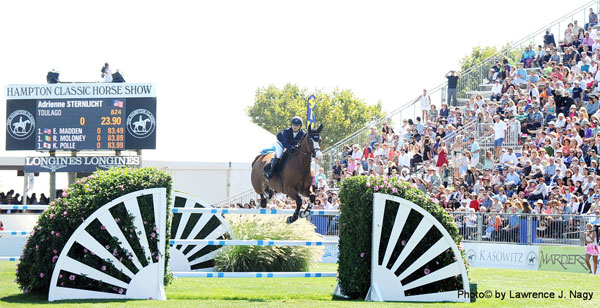When you go to McDonald’s, you know what to expect. Ditto the mid-range Outback Steakhouse and the high-end Ruth’s Chris Steakhouse. But at U.S. Equestrian Federation-recognized horse shows, the nomenclature doesn’t always reflect what’s actually on the menu.
As exhibitors arrive at a show rated Premier, they don’t anticipate finding less-than-ideal stabling, or perhaps footing that isn’t up to snuff. But some of those shows aren’t meeting competitors’ expectations. And although the USEF has many responsibilities as the USA’s National Governing Body, the recognized shows still have to be considered the bread and butter of its existence.
Frank Madden, the USEF competition standards committee chairman who offers the restaurant analogy, said his panel is working on a way to insure the designation fits the show.
“This whole concept was based on trying to make sure our exhibitors, our membership, are really getting a clear picture as to what kind of horse show they’re coming to,” he said, hoping the “very complicated” process can be completed by 2020. Happily, the committee isn’t getting a lot of pushback from managers, Frank added.
“The direction the committee is heading in is trying to legitimize the standards of all the different level horse shows, starting with Premier, going down to National, then the two Regionals and then Local,” he pointed out.
With annual licensing, the days are gone when a substandard show could keep its date in perpetuity, preventing other, better shows from having a chance to become recognized and earn a place on the calendar.
In addition to the work of Frank’s committee, the USEF is taking a close look across the board at how to handle the shows that it recognizes. It has set up a task force considering the way competitions are licensed and how the increasingly crowded calendar can be managed better. Being taken into account are factors such as competitor density, diversity of competition venues and accessibility to competitions at all economic levels, among others. Compliance officer Matt Fine also is involved in the process of insuring shows are up to snuff.
At this point, there are approximately 255 shows with that Premier rating, according to Frank, and not all those shows live up to what Premier implies. His committee is focused on winnowing out the ones that don’t belong in that category, “so that number will end up dropping dramatically and a lot of those will end up being National horse shows,” the next level down.
“We’re trying to change the standard,” he said, mentioning that the committee had a retreat last month to discuss what criteria should be used to separate Premier from the rest. While the jumpers are part of the picture, “it’s more of a hunter issue at the moment,” said Frank.
“Our goal is to come up with a number of A-rated sections a Premier horse show has to fill,” said Frank, explaining there are 25 possibilities for A-rated offerings. At present, some shows rated Premier can only fill two sections. Under consideration could be a requirement of from 16 to 20 sections.
“If we make the A-rated sections mandatory to fill, that’s going to be the biggest pressure on horse shows; if they can’t fill those sections, they’re going to have to become National horse shows.”
At the same time, he emphasized, “the committee is not trying to limit any of the low-end divisions that are so heavily supported by these big horse shows.”
The number of A-rated sections is among “many other standards” that are in place to determine a show’s designation. The committee is trying to refine that roster, and is discussing a star system that could rank Premier shows from 1 to 5 stars, along the lines of the way FEI jumper shows are rated.
While talking with exhibitors about what goes on at the various shows, Frank said, it often turns into a conversation about “the horse show experience.”
“Our committee is really trying to focus on sticking to things that can be measured and defined. If we were to put this star system in place, we would also be improving the actual experience at a horse show,” said Frank.
A point system for a la carte list of basics and amenities hasn’t been decided on, but the panel is working in that direction, Frank states, “to have very identifiable things that we can measure and evaluate.”
As an example, he said, a jumbotron with a live stream on it might be worth 30 points. If shows can’t do that, he said, they can choose other things with a point value from the list, such as permanent restrooms or wider stable aisles, that would add up for them.
All this is in addition to making sure a show has the right big-picture, fundamental compulsory standards, including footing, stabling, sufficient warm-up areas and ring size. Without such proper basics, a show could lose its rating.
“We’re making sure standards are in place at all the different ratings. In a big country like this, you have to take so many things into account,” said Frank.
“The one thing we’re trying not to do is create such an over-regulated environment that it becomes more expensive for the horse shows and more expensive for exhibitors.”
~Nancy Jaffer

